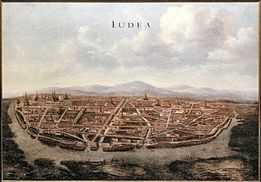Massaman curry
| Massaman curry | |
|---|---|
|
Chicken massaman | |
| Type | Curry |
| Place of origin | Thailand |
| Main ingredients | Meat (beef, duck, tofu, chicken), coconut milk, onion, peanuts or cashews, potatoes, bay leaves, cardamom pods, cinnamon, star anise, palm sugar, fish sauce, chili and tamarind sauce |
|
| |
Massaman curry (Thai: แกงมัสมั่น, rtgs: kaeng matsaman, IPA: [kɛːŋ mát.sa.màn]) is a rich, relatively mild Thai curry that is an interpretation of a Persian dish.[1]
Description

Massaman or matsaman is not a native Thai word. It is generally thought to refer to the Muslims with earlier writers from the mid-19th century calling the dish "Mussulman curry"; Mussulman being an archaic form of the word Muslim.[2][3]
According to Thai food expert David Thompson, as well as Thai journalist and scholar Santi Sawetwimon, the dish originated in 17th century Central Thailand at the cosmopolitan court of Ayutthaya, through the Persian merchant Sheik Ahmad Qomi from whom the Thai noble family of Bunnag descends.[4] Other theories contend that massaman is a southern Thai dish, influenced by Malay and Indian cuisine,[5] or that its name is derived from the Malay word masam, which means "sour".
The curry is extolled in a poem from the end of the 18th century, attributed to Prince Itsarasunthon of Siam, the later King Rama II (1767-1824). It is dedicated to a lady who is believed to be Princess Bunrot, the later Queen Sri Suriyendra, wife of King Rama II. The second stanza of the poem reads:[6][7]
มัสมั่นแกงแก้วตา หอมยี่หร่ารสร้อนแรง - Massaman, a curry made by my beloved, is fragrant of cumin and strong spices.
ชายใดได้กลืนแกง แรงอยากให้ใฝ่ฝันหา - Any man who has swallowed the curry is bound to long for her.
Due to its Muslim roots and therefore Islamic dietary laws, this curry is most commonly made with beef, but there are also variations on this dish using duck, chicken, mutton, goat, or, less commonly so, pork.[8][9] As pork is haram meat - forbidden food in Islam - this last variant is of course not eaten by observant Thai Muslims. Vegetarians and vegans have created their own versions of this dish.

The flavors of the massaman curry paste (nam phrik kaeng matsaman) come from spices that are not frequently used in other Thai curries. Cardamom, cinnamon, cloves, star anise, cumin, bay leaves, nutmeg and mace would, in the 17th century, have been brought to Thailand from the Malay Archipelago and South Asia by foreigners, a trade originally dominated by Muslim traders from the Middle East, Indian subcontinent and from the archipelago itself, but increasingly threatened by the Portuguese, the Dutch and French East India Company.[10] These are combined with local produce such as dried chili peppers,[11] cilantro (coriander) seeds, lemongrass, galangal, white pepper, shrimp paste, shallots and garlic to make the massaman curry paste. This paste is first fried with coconut cream, and only then are meat, potatoes, onions, fish sauce or salt, tamarind paste, sugar, coconut milk and peanuts added.[12][13] Massaman is usually eaten with rice, in a meal together with other dishes. There are also traditional versions using oranges, orange juice, or pineapple juice as additional ingredients.[14][15]
Media coverage
In 2011 CNNGo ranked Massaman curry as number one in an article titled World's 50 most delicious foods.[16] However, CNN's voter's survey later that year ranked it only 10th.[17]
See also
References
- ↑ David Thompson, Thai Food (edition 2010), Pavilion Books, pages 329, ISBN 978-1-86205-514-8
- ↑ The Magazine of Domestic Economy, Volume 5, p.63 (Google eBook), W.S. Orr & Company, 1840, accessed 2014-08-17: "A Mussulman Curry is made in the same way..."
- ↑ Sorties into Thai cultural history, Office of the National Culture Commission, Ministry of Education, 1982, accessed on Google Books 2014-08-17
- ↑ http://www.scholarbank.nus.edu.sg/bitstream/handle/10635/17685/2.%20Thesis%20body%20-%20What%20is%20Thai%20Cuisine.pdf?sequence=2 p.25-26
- ↑ "Southern Thai Massaman Curry » Temple of Thai Food". Temple of Thai Food.
- ↑ The complete poem in th.wikisource.org (in Thai)
- ↑ http://shesimmers.com/2010/07/massaman-matsaman-curry-recipe-%E0%B9%81%E0%B8%81%E0%B8%87%E0%B8%A1%E0%B8%B1%E0%B8%AA%E0%B8%A1%E0%B8%B1%E0%B9%88%E0%B8%99.html The translation is partially based on the one in Leela Punyaratabandhu's article
- ↑ "Thai Muslim Goat Curry (Wednesday Photo)". Thai Food and Travel Blog.
- ↑ "Thai Massaman Curry Recipe » Temple of Thai". Temple of Thai.
- ↑ http://journalarticle.ukm.my/514/1/1.pdf p. 208-212
- ↑ Cummings, Joe (2000). World Food: Thailand. Melbourne, Australia: Lonely Planet. p. 79. Chili peppers from the Americas were introduced to the region by the Spanish and Portuguese during the 16th and 17th century
- ↑ "Massaman Curry Paste - Prig Gang Mussamun พริกแกงมัสมั่น". ThaiTable.
- ↑ Leela. "Massaman (Matsaman) Curry Recipe". SheSimmers.
- ↑ "Beef Massaman Curry Recipe". ThaiTable.
- ↑ http://www.abc.net.au/tasting/ep3.htm David Thompson's Mussaman Curry of Duck
- ↑ CNNGo staff (21 July 2011). "World's 50 most delicious foods". CNNGo. Cable News Network. Retrieved 20 September 2011.
- ↑ CNNGo staff (7 September 2011). "World's 50 most delicious foods". CNNGo. Cable News Network. Retrieved 29 September 2012.
| ||||||||||||||||||||||||||||||||||